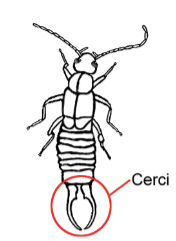Entomology
1/84
Earn XP
Description and Tags
UCR ENTM 010
Name | Mastery | Learn | Test | Matching | Spaced |
|---|
No study sessions yet.
85 Terms
Abdomen structure/ function
The abdomen is the back section of an insect's body, primarily responsible for digestive, reproductive, and respiratory organs. It plays a critical role in movement and flexibility.
Ametabolous development
Ametabolous development refers to a type of insect development where the young resemble miniature adults, without distinct larval stages. This type of development is typical in insects like silverfish and bristletails.
Annelida
A phylum of invertebrate animals known as segmented worms, including earthworms and leeches. Annelids have bodies divided into segments and exhibit both aquatic and terrestrial habitats.
Antenna types
Geniculate: elbow shaped antennae
Plumose: feathery-like antennae (male mosquitos)
Aristate - bristle like antennae
Aposematic coloration
a way for insects to warn to predators (mimicry) by using bright colors or patterns that indicate toxicity or unpalatability.
Arthropoda
A phylum of invertebrate animals characterized by jointed limbs, a chitinous exoskeleton, and segmented bodies, including insects, arachnids, and crustaceans.
Auditory receptor
A sensory organ in insects that detects sound vibrations, often located on the antennae, thorax, abdomen
Binomial nomenclature
Hierarchical system to place organisms in relation to each other.(e.g., Kingdom, Phylum, Class (Super and sub), Order, Family, Genus, Species)
Biodiversity and abundance of insects
Based on the number of known species (all animals, all plants, all virus, all bacteria, all fungi…), of the approximately 2.1 million presently recognized, about 1 million are insects.
This term refers to the variety of different insect species and their populations within a specific ecosystem or environment. It highlights the ecological importance and roles that insects play in maintaining healthy ecosystems.
Body design of insects
refers to the structural and functional characteristics that define the physical form of insects, including their segmentation, exoskeleton, and specialized appendages.
Book lung
a respiratory structure found in certain arachnids, consisting of stacked, thin membranes that allow for gas exchange.
Centipede vs. millipede
Centipedes are elongated arthropods with one pair of legs per body segment and are typically carnivorous, while millipedes have two pairs of legs per segment and primarily feed on decaying plant matter.
Cephalothorax
the fused body region of an spider that combines the head and thorax, housing the eyes, mouthparts, and legs.
Cerci
Singular of cercus, sticks out from tip of abdomen, sense wind and air movements, Earwigs = pinchers

Chelicerata
a subphylum of arthropods that includes arachnids, such as spiders and scorpions, which possess chelicerae, or jaw-like mouthparts.
Chemoreception
pheromones: trail marking, aggregation, sex pheromone)
Closed circulatory system
blood stays in the blood vessels and is pumped by the heart, allowing for more efficient transport of nutrients and oxygen.
Compound eye
(Ocellus) type of eye found in insects and some crustaceans, consisting of many small visual units called ommatidia.
Responds to UV: nectar guide in flower - detected by pollinator insects.
Crustacea
a diverse group of aquatic arthropods, including crabs, lobsters, and shrimp, characterized by a hard exoskeleton and two pairs of antennae.
Diapause
period of dormancy (state of suspended/slowed growth) that some insects enter in response to environmental conditions, allowing them to survive unfavorable conditions.
what are the different types of metamorphosis?
Ametabolous: group, most primitive (silverfish, brisitletails) - adult, sexually mature. Adults look identical to nymphs
Hemimetabolous: incomplete metamorphosis. Adults and immature: adults look like nymph expect for wings. Adults and
Holometabolous: complete metamorphosis, adults different from larvae, PUPAL stage. WINGS, sexually mature.
Dorsal vessel
Ecdysone
Ecological implication of insect
metamorphosis
Exuviae
Fat body
Female accessory gland
Functions of insect body regions
Gas exchange
Head structure / function
Hemimetabolous development
Hexapoda
Holometabolous development
Hormonal regulation of insect
metamorphosis
Insect body size
Insect brain
Insect digestive system / alimentary cana
Insect excretory system
Insect hemolymph
Insect leg structure / types
Insect metamorphosis
Insect molting process
Insect tagmata
Insect wing structure / types
Insects as food
Instar
Male / female reproductive organ
Male accessory gland
Malpighian tubule
Mechanoreception
Modifications of insect wing
Molting
Monophyletic group
Ocelli
Ommatidia
Onychophora
Open circulatory system
Ostia
Parthenogenesis
Polyphyletic group
Polyphyletic group
Reason to study insects
Reasons for the evolutionary “success” of
insects
Rectum
Reflexive bleeding
Relationship among taxa
Respiratory organs
Sexual selection vs. natural selection
Sociality in insect
Spermatheca
Spermatophore
Spiders
Stadium
Stemmata
Strong benefit of complete metamorphosis
Structure of insect exoskeleton
Structures on insect abdomen
Territorial behavior
Thorax structure / function
Tracheal system
Types of mimicry
Ventral nerve cord
What is evolution?
What is insect?
Why study insects?